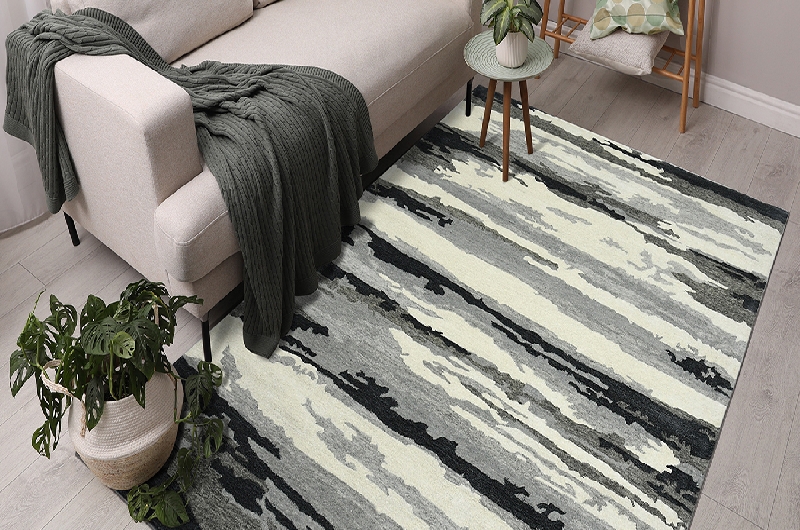
Rugs of various hues and textures can be mixed and matched to add a lot of visual interest to your space. It's simpler than it seems, and it can show you new applications for your current rugs. One of the simplest ways to give a space a little something is to add a rug. With so many possibilities available, why limit yourself to just one? A style that has been shown to last is layering various floor coverings on top of one another.
Layering Fundamentals:
You can utilize your smaller rugs in larger settings and radically change the décor of your rooms by layering your designer carpets. We suggest beginning with a decent foundation rug. The foundation carpeting must be neutral; examples are plain, jute, sisal, stripes, or a black-and-white design. Even though the goal is to layer, it will be advantageous if the base carpeting can support the décor on its own. Just in case you decide to live simply. Choose a neutral base carpeting that can be piled up to change the look of the space.
Coordinate Rather than Duplicate:
Consider your base rug and your layered accent rug when layering rugs to make sure they work in concert rather than competing with one another. Therefore, the days of matchy-matchy are over. When choosing your base rug, keep the color scheme of the space in mind, but when it comes to the top layer, get creative! A clever focus point and an unexpected addition to your overall room can both be made by your second rug.
Consider using two distinct tones of the same color for a more restrained effect, or make a statement with hues on the opposing sides of the color wheel (looking at you, yellow and purple!). Additionally, your accent rug can coordinate with other colors in your room, such as throw pillows or a wall painting.
Pattern Blending:
What is your foolproof recipe for stylish stacking rugs? A striking animal print rug is placed on top of a simple, organic, neutral base. A natural jute or sisal rug gives the room a contrasting texture and provides the ideal background for a design to stand out without appearing packed or crowded. It's the ideal method to step just a little bit outside of your design comfort zone while yet contributing to the harmony of the room.
Play with contrast by placing a darker rug on top of a lighter, neutral-colored rug if you're looking for more secure water. A modest yet striking statement like black or navy blue can radically change the atmosphere of your room and create a more special scene.
Take the Space into Account:
The greatest places for layering rugs are rooms with little furniture, like a bedroom, living room, or den. If the space has solid walls, mixing and matching patterns are possible. If your room contains wallpaper with prints, you might want to consider matching it with a plain rug to give it more cohesion. This would make your room appear larger and contribute to the cozy environment.
Play Around with the Sizes:
Choosing the appropriate size rugs for layering is its main component. The best way to accomplish this is to layer smaller rugs on top of a wall-to-wall carpet in your room. If you want, you may just fill up a room with smaller rugs from the same color or pattern family to provide a distinctive touch. When guests visit your space, keep the smaller rugs in a basket and roll them over.
Biased Layering:
The best approach to layer is always on a bias. You can create this effect by placing your large rug as fully as you can, always in the direction of the shape of your space. By angling a smaller rug, you can add a bias to this straight rug. Feel free to experiment and see what angle works best because you can only get the greatest results for this once you are really in the location.
Infallible Combinations:
Black or blue carpeting on any neutral tone can work for most rooms, and there are more tried-and-true options that can help you layer your space. For bedrooms, playrooms, and even foyers, a rug with a black-and-white pattern can serve as a terrific foundation for a rainbow of colors.
Just be certain and wear layers! You'll adore the design options it gives you for your home.
Enjoy Yourself:
Fire emphasizes that there are actually no regulations when it comes to piling carpets despite these recommendations. There are numerous ways to use rugs to become the next big design star, according to her. "Follow your instinct, or push yourself a little bit and attempt something that you wouldn't normally do. Imperfect is the new perfect, I often say."
Even though some of us may shudder at the concept of diagonals or anything out of the ordinary, laying rugs at an angle can really add a humorous element to a more formal design. It can also be a useful technique to show a visitor around the house or enlarge the designated space of a room.
Place a smaller rug at an angle over the base layer to help anchor a space when the main rug is insufficient. Using this technique will also allow you a clear path from the living room to the kitchen for those snack and wine refills and visually enlarge a modest furniture arrangement.